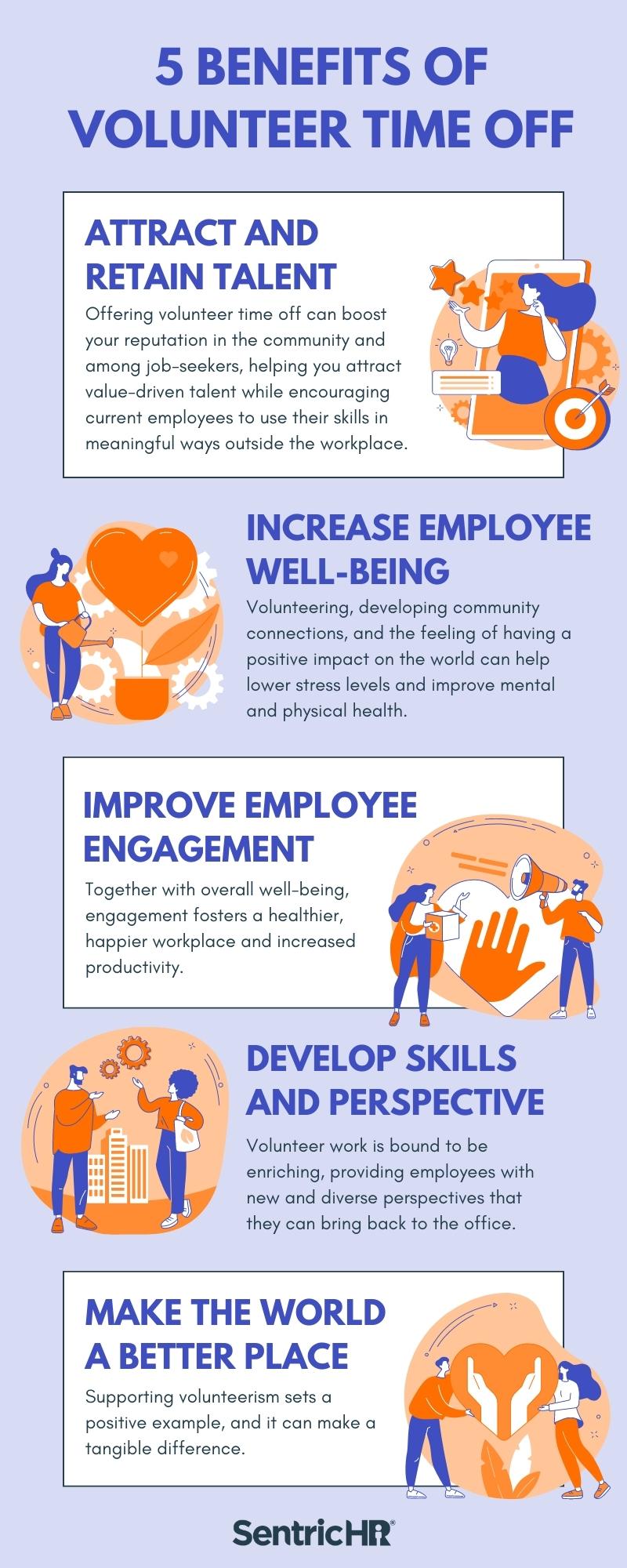Key points:
- Volunteer time off pays employees to volunteer in their communities.
- Volunteer time off programs boost morale and engagement, help attract and retain employees, and build community connections.
- A clear volunteer time off policy is crucial to achieving benefits and avoiding abuse of the program.
- Time tracking software can help you record different types of paid leave, including volunteer time off.
Faced with the Great Resignation, employers of all sizes are looking for new ways to engage employees, boost employee satisfaction, and retain top talent. Volunteer time off is one slightly unconventional way you can do that.
Research shows that 75% of American adults feel physically healthier due to volunteering—and 93% report it improves their mood. But only about 26% of employers are financially supporting employees to volunteer. Implementing a volunteer time off program may be a way to set your company apart, while also doing good for your employees and the community.
What is volunteer paid time off?
Volunteer time off is when companies offer employees paid leave to volunteer for a non-profit or community group. It can be a few hours or several days a year, depending on the employer. Volunteer time off doesn’t cut into vacation, bereavement, or sick leave.
5 benefits of volunteer time off
A well-planned volunteer time off program offers a range of benefits to employers, employees, and their communities, including:
1. Attract and retain talent
Increasingly, people want to work for employers who share their values and goals. In fact, 75% of millennials say they would take a pay cut to work for a socially responsible company. Offering volunteer time off can boost your reputation in the community and among job-seekers, helping you attract value-driven talent while encouraging current employees to use their skills in meaningful ways outside the workplace.
2. Increase employee well-being
Volunteering, developing community connections, and the feeling of having a positive impact on the world can help lower stress levels and improve mental and physical health.
3. Improve employee engagement
Supporting your employees to give back to the community inspires pride and company loyalty. Together with overall well-being, engagement fosters a healthier, happier workplace and increased productivity.
4. Develop skills and perspective
Volunteer time off doesn’t have to be about professional development, but it can be a chance to hone leadership, communication, or other skills. Volunteer work is bound to be enriching, providing employees with new and diverse perspectives that they can bring back to the office.
5. Make the world a better place
That’s what we all want to do, isn’t it? The contributions of your employees will have an impact, large or small. They can apply what they learn both inside and outside the workplace. Supporting volunteerism sets a positive example, and it can make a tangible difference.
What are the downsides of volunteer time off?
Productivity. You’ll have to find a balance between the morale-boosting effects of volunteer time outside the office and ensuring that the work gets done inside it. An additional day away may place a burden on other employees—something that is especially noticeable in a small business.
Schedule volunteer time off in advance and be sure colleagues are aware of any planned absences. If a full day of volunteer time off doesn’t work for your business, consider offering half-days or extended lunch breaks.
Potential PR headaches. An employee may decide to give their time to a for-profit organization or a group that doesn’t align with your corporate goals. To avoid this potential tangle, set clear rules or guidelines about where your employees can volunteer while on company time. Do you have a relationship with specific community non-profits already? Can employees volunteer for a political organization? You may wish to offer a short list of non-profits to select from. These parameters can be set in your volunteer time off policy (more on this below).
How do you implement a volunteer time off program?
As with any new program, the first step is to define your objectives. Knowing your goals will help you structure your program. For example, if building camaraderie within the office is a priority, you may plan a one-day group activity, such as helping with a home or community garden build. If individual skill-building is more important, you might encourage employees to search out opportunities that match their specific interests. By offering volunteer time off, do you hope to:
- Boost your reputation in the community?
- Build employee skills?
- Recruit and retain employees?
- Foster engagement and community-building within your office?
- Provide meaningful experiences?
- Be a better corporate citizen?
Next, ensure buy-in across the company. Make sure managers understand how volunteer time off works, how requests will be filed, and how hours will be tracked. This can be covered in your volunteer time off policy.
What should a volunteer time off policy include?
A well-crafted volunteer time off policy is clear, thorough, and will help you avoid misunderstandings (or, worse, abuse). The policy should include the answers to these 9 questions:
- Who may participate?
- How many hours out of office are available per month or per year?
- When and how is a volunteer time off request made?
- Will you develop and use a volunteer time off request form?
- Who will approve the request?
- Where can the employee volunteer?
- How do you vet a volunteer opportunity?
- How will you audit or verify the volunteer work?
- How will you track volunteer hours?
Engage your employees—and feel good doing it
Volunteer time off can be a valuable part of your social responsibility program and a great way to connect with your community. As an employee perk, it’s a relatively low-cost and easy-to-implement way to boost engagement and retention, and it shows you care.
A successful volunteer time off program requires planning, a clear policy, and a way to keep track of hours and initiatives. An HRIS can help you track employee schedules, hours, and different types of leave, including volunteer time off.
To learn more about employee scheduling solutions, check out our blog post about the Top 10 Benefits of Employee Scheduling Software.









